An automatic watch, also known as a self-winding watch, is a mechanical watch that doesn’t require manual winding to keep running. Instead, the watch uses the natural motion of the wearer’s wrist to wind the mainspring and power the watch. The invention of the automatic watch is a significant milestone in the history of watchmaking and has contributed to the popularity of mechanical watches in the modern era.
How an Automatic Watch Works
An automatic watch uses a rotor, a semi-circular weighted piece that moves freely in the watch movement. When the wearer moves their wrist, the rotor rotates and transfers energy to the mainspring through a series of gears. The mainspring is then wound, which powers the watch. The power reserve of an automatic watch can range from a day to several days depending on the specific watch and movement.
Benefits of an Automatic Watch
The main benefit of an automatic watch is that it doesn’t require manual winding like a traditional mechanical watch. This means that the watch can keep running as long as it’s worn regularly. It also means that the watch is less prone to running out of power unexpectedly, which can be a significant inconvenience.
Additionally, automatic watches are often viewed as more desirable than quartz watches because of their craftsmanship and history. Automatic watches require a high level of skill and precision to manufacture and assemble, and they represent the pinnacle of mechanical watchmaking. Owning an automatic watch can be a symbol of prestige and a connection to the art and history of watchmaking.
How to Maintain an Automatic Watch
While automatic watches don’t require manual winding, they do require regular maintenance to keep them running accurately and reliably. Over time, the movement can become dirty or worn, and the watch may require cleaning, lubrication, or adjustment. It’s recommended that an automatic watch is serviced by a professional watchmaker every three to five years, depending on the specific watch and usage.
In addition to regular servicing, automatic watches require regular wear to keep them running. If an automatic watch isn’t worn regularly, the power reserve can run down, and the watch may stop. Some automatic watches also have a power reserve indicator that can help the wearer monitor the remaining power in the watch.
In summary, an automatic watch is a self-winding mechanical watch that uses the natural motion of the wearer’s wrist to power the watch. Automatic watches offer several benefits over traditional mechanical watches, including convenience and prestige. However, they do require regular maintenance to keep them running accurately and reliably, and they should be serviced by a professional watchmaker every few years. Overall, automatic watches are a fascinating and impressive example of the craftsmanship and engineering that goes into mechanical watchmaking.












































